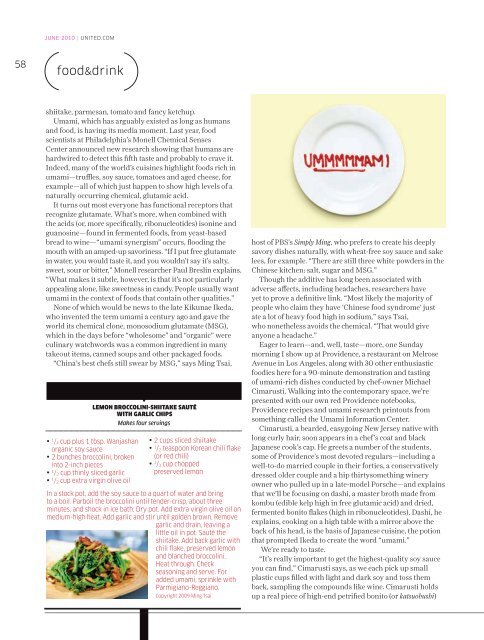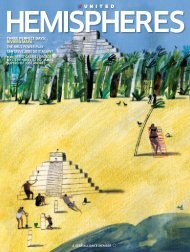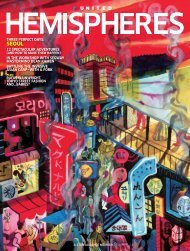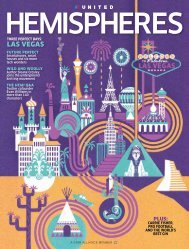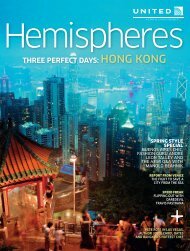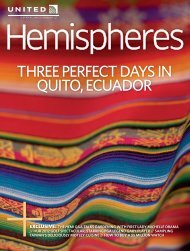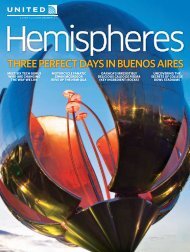june-2010
june-2010
june-2010
Create successful ePaper yourself
Turn your PDF publications into a flip-book with our unique Google optimized e-Paper software.
58<br />
JUNE <strong>2010</strong> | UNITED.COM<br />
food&drink<br />
shiitake, parmesan, tomato and fancy ketchup.<br />
Umami, which has arguably existed as long as humans<br />
and food, is having its media moment. Last year, food<br />
scientists at Philadelphia’s Monell Chemical Senses<br />
Center announced new research showing that humans are<br />
hardwired to detect this fi fth taste and probably to crave it.<br />
Indeed, many of the world’s cuisines highlight foods rich in<br />
umami—truffl es, soy sauce, tomatoes and aged cheese, for<br />
example—all of which just happen to show high levels of a<br />
naturally occurring chemical, glutamic acid.<br />
It turns out most everyone has functional receptors that<br />
recognize glutamate. What’s more, when combined with<br />
the acids (or, more specifi cally, ribonucleotides) isonine and<br />
guanosine—found in fermented foods, from yeast-based<br />
bread to wine—“umami synergism” occurs, fl ooding the<br />
mouth with an amped-up savoriness. “If I put free glutamate<br />
in water, you would taste it, and you wouldn’t say it’s salty,<br />
sweet, sour or bitter,” Monell researcher Paul Breslin explains.<br />
“What makes it subtle, however, is that it’s not particularly<br />
appealing alone, like sweetness in candy. People usually want<br />
umami in the context of foods that contain other qualities.”<br />
None of which would be news to the late Kikunae Ikeda,<br />
who invented the term umami a century ago and gave the<br />
world its chemical clone, monosodium glutamate (MSG),<br />
which in the days before “wholesome” and “organic” were<br />
culinary watchwords was a common ingredient in many<br />
takeout items, canned soups and other packaged foods.<br />
“China’s best chefs still swear by MSG,” says Ming Tsai,<br />
LEMON BROCCOLINI-SHIITAKE SAUTÉ<br />
WITH GARLIC CHIPS<br />
Makes four servings<br />
• 1 /4 cup plus 1 tbsp. Wanjashan<br />
organic soy sauce<br />
• 2 bunches broccolini, broken<br />
into 2-inch pieces<br />
• 1 /3 cup thinly sliced garlic<br />
• 1 /2 cup extra virgin olive oil<br />
• 2 cups sliced shiitake<br />
• 1 /2 teaspoon Korean chili fl ake<br />
(or red chili)<br />
• 1 /3 cup chopped<br />
preserved lemon<br />
In a stock pot, add the soy sauce to a quart of water and bring<br />
to a boil. Parboil the broccolini until tender-crisp, about three<br />
minutes, and shock in ice bath. Dry pot. Add extra virgin olive oil on<br />
medium-high heat. Add garlic and stir until golden brown. Remove<br />
garlic and drain, leaving a<br />
little oil in pot. Sauté the<br />
shiitake. Add back garlic with<br />
chili fl ake, preserved lemon<br />
and blanched broccolini.<br />
Heat through. Check<br />
seasoning and serve. For<br />
added umami, sprinkle with<br />
Parmigiano-Reggiano.<br />
Copyright 2009 Ming Tsai<br />
host of PBS’s Simply Ming, who prefers to create his deeply<br />
savory dishes naturally, with wheat-free soy sauce and sake<br />
lees, for example. “There are still three white powders in the<br />
Chinese kitchen: salt, sugar and MSG.”<br />
Though the additive has long been associated with<br />
adverse aff ects, including headaches, researchers have<br />
yet to prove a defi nitive link. “Most likely the majority of<br />
people who claim they have ‘Chinese food syndrome’ just<br />
ate a lot of heavy food high in sodium,” says Tsai,<br />
who nonetheless avoids the chemical. “That would give<br />
anyone a headache.”<br />
Eager to learn—and, well, taste—more, one Sunday<br />
morning I show up at Providence, a restaurant on Melrose<br />
Avenue in Los Angeles, along with 30 other enthusiastic<br />
foodies here for a 90-minute demonstration and tasting<br />
of umami-rich dishes conducted by chef-owner Michael<br />
Cimarusti. Walking into the contemporary space, we’re<br />
presented with our own red Providence notebooks,<br />
Providence recipes and umami research printouts from<br />
something called the Umami Information Center.<br />
Cimarusti, a bearded, easygoing New Jersey native with<br />
long curly hair, soon appears in a chef’s coat and black<br />
Japanese cook’s cap. He greets a number of the students,<br />
some of Providence’s most devoted regulars—including a<br />
well-to-do married couple in their forties, a conservatively<br />
dressed older couple and a hip thirtysomething winery<br />
owner who pulled up in a late-model Porsche—and explains<br />
that we’ll be focusing on dashi, a master broth made from<br />
kombu (edible kelp high in free glutamic acid) and dried,<br />
fermented bonito fl akes (high in ribonucleotides). Dashi, he<br />
explains, cooking on a high table with a mirror above the<br />
back of his head, is the basis of Japanese cuisine, the potion<br />
that prompted Ikeda to create the word “umami.”<br />
We’re ready to taste.<br />
“It’s really important to get the highest-quality soy sauce<br />
you can fi nd,” Cimarusti says, as we each pick up small<br />
plastic cups fi lled with light and dark soy and toss them<br />
back, sampling the compounds like wine. Cimarusti holds<br />
up a real piece of high-end petrifi ed bonito (or katsuobushi)


